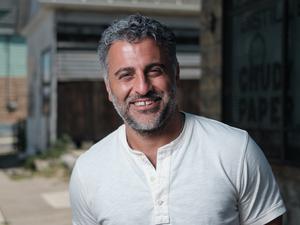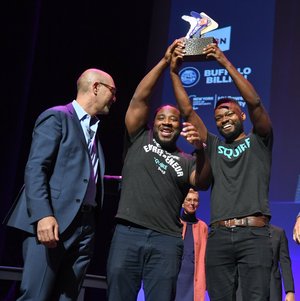Malkijah Griffiths finds the nearest bathroom. He walks to the mirror. He talks to himself.
“You are the best,” he says. “You are the expert. You put in the work.”
There is nothing easy about asking investors to fund a high-growth startup. Every room has its own unpredictable nature, each set of eyes looking for something different.
And the stakes are high – the intersection of one person’s dreams and another’s hard-earned cash.
Business First asked local entrepreneurs what they’ve learned about the process.
Malkijah Griffiths, co-founder and CEO, Team Real Talk
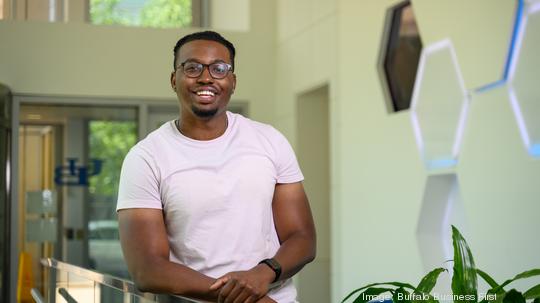
A Queens native, Griffiths came to the University at Buffalo in 2015 and recently graduated after earning an MBA and master’s degree in public health.
But what Griffiths really wants to do is build his own firm. Enter Team Real Talk, founded with fellow UB alum Sonya Tareke as a diversity, equity and inclusion consultancy within a high-growth model.
The duo has pitched and pitched and pitched and pitched over the last two years, getting bounced early in UB’s Panasci competition in 2021 before winning first place this year. Team Real Talk was also accepted into UB’s Cultivator accelerator program last year, which came with a $50,000 investment.
Griffiths became the startup’s first fulltime employee this July. He said the self-affirmations are just the last mile of a long road.
“When you get on that stage or that Zoom call, you have to understand that they know they’re going to invest in you within the first 30 seconds. They’ve seen a thousand pitches before, a thousand entrepreneurs from different backgrounds, ages, etc. They’re able to pick up on things before you even get to the business model.
You have to show them confidence and charisma. Sonya and I built Real Talk because we’re very passionate about having these conversations through the organization. We have both been through things personally and wish we had something like Team Real Talk. We know what it can do for lower-level employees, for high-ranking employees. We try to show that passion and that confidence.
I’ve been surprised by how much emphasis people put on business projections. You might think ‘it’s real but it’s not really real, because it’s hard to predict how much money you’re making in 10 years.’ But they’re going to ask you that. They’re going to ask you about 2030. Early on, I didn’t realize you needed to have it fine-tuned, but you have to have everything down to a T.
You have to put the work in. You’re asking investors to put their money in, or their company’s money in, and their name is on the line as well. You don’t want to be using their money to create a value proposition. We pitched this idea to probably 50 people in the community and (at UB) before we won the Panasci competition. You respect their questions. You have numbers backing up your points. You make sure you’re not selling them a fantasy.”
Carley Hill, founder and CEO, CaHill Tech
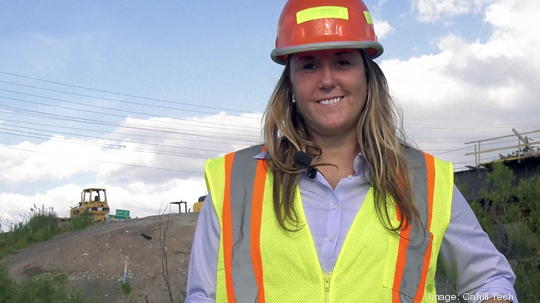
Carley Hill slips on her headphones. It might be Kanye West — the early stuff. It might be Grimes. But most likely, it’s Flux Pavilion’s upbeat “I Can’t Stop.”
She’s a woman in a set of industries – construction and tech – that skew traditionally male. As she prepares to pitch her startup company, she’s looking for those power vibes.
Hill grew up in the construction industry in her family’s business, Union Concrete and Construction.
She is taking that experience in her own direction.
HIll is the founder and CEO of CaHill Tech, a software-as-a-service business targeting the construction industry. CaHill has raised about half of a $1 million seed round, has nine employees and recently entered the Techstars Iowa accelerator program.
“What works is preparation. There is a certain amount of shooting from the hip, but the less prepared you are, the more difficult things become and the less confidence you have in your own story.
We’re talking about risk-taking and taking chances and people on both sides need confidence and belief in each other. I’ve found that if I’m not fully prepared on something, let’s say it’s marketing or financial modeling, then things unravel because that risk and that chance-taking energy is always in the room. But the more I’m able to exude confidence when it comes to answering questions outside of my domain, it makes it easier for everyone to trust one another and keep the ball rolling toward a deal.
Construction is not a sexy industry, and sometimes I’m in a group and someone will say, ‘Oh, construction, do you know why the lights on my street aren’t synchronized?’ I’m like, ‘Ok, wow.’ It takes a special kind of person to see an opportunity, to understand that this is a massive market that has sustained and grown through every kind of challenge. People who get that understand this touches every single American and every single person in the world. When people get that, then it’s the right conversation.
I’m a female founder and there are not a lot of us out there. People are still learning to trust that we are confident and capable of crushing it. That is another barrier, so if someone doesn’t get the market opportunity and doesn’t get that women are crushing it every day, they’re not worth my time.
The point is, with a limited amount of time and energy and bandwidth, you have to make sure you are taking quality meetings.
You have to be authentic to yourself. I know sometimes i have been really nervous and get out of sorts and know I’m not speaking my truth. Your game face is huge because you have to be ready to speak your truth and have fun with it. A lot of investors are in this because they enjoy the ride so you have to understand that your personality matters. If they invest, they are going to be with you for the lifetime of the company and they have to understand who you are and be comfortable with you.
The last thing is to sometimes pause and listen and let people ask questions. You don’t need to fill the space just because you are nervous and you’ve put so much into this. There is a key to pitching which is holding something back and letting the other person fill the space a little too. This is a collaboration. You’re both bringing something to the table and together you’re hoping to create something really explosive, in a good way.”
Jimmy Chebat, founder and CEO, Zizo Technologies
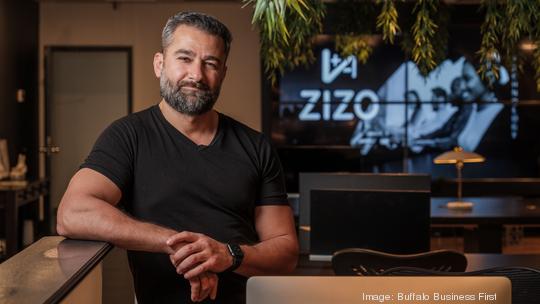
The self-affirmations. The power poses. The structured meditation processes.
It’s taken Jimmy Chebat awhile to get beyond the idea that such practices are gimmicky or embarrassing.
Learning to accept that there are specific ways to boost confidence, concentration and relaxation is one of the many things he’s learned over the past few years of pitching Zizo Technologies to investors.
Launched last year, Zizo is a “gamified” suite of tools aimed at incentivizing workers with real-time feedback. Chebat says it could be a key retention tool for employers within a tight national workforce.
Chebat says his company is preparing to scale by switching its emphasis from development to growth, with new hires on deck and Buffalo-based Yamu Media launching a digital marketing initiative.
“Every investor expects something different. There’s no universal template or format for pitching. I think most people agree that the founder and their enthusiasm are important parts of it, but it has to be substantiated with a good deck that’s going to explain the product in enough detail but not too much, the total addressable market in enough detail but not too much.
There is a wide array of information that needs to be shared but it has to be done in a limited period of time and that’s where the tricky part comes in, because which information is most relevant all depends on the investor.
One thing I’ve learned is that the deck you send to people should be efficient, shorter and have less details. You don’t want to put a ton of information on each page but it has to be efficient in getting that information across to really pique the interest of the investor so they can take it to the next step, which is the presentation. The deck is a difficult and elusive piece – i probably have 20 different versions of my pitch deck and I still don’t believe I have the right version for everyone. So I’m still learning, even though I’ve been doing this for a few years.
I know this sounds counterintuitive, but something I’ve learned is to have a certain amount of not caring. Like ‘Hey, this isn’t going to make or break me. This isn’t the end of the world. You know you’re going to get 99 nos before you get a single yes.
I’ve started to do some affirmations. We’re in that generation that considers those things embarrassing or gimmicky, but there’s a lot to be said about how they help. I’m working toward a more structured meditation process. I’ve done a power pose. I’m still not looking at myself in the mirror, but I am talking to myself about not relying on other people’s judgment, which helps me go in there feeling positive and confident.”

